|
CÁCERES IN PUERTO
RICO - their origins?
//www.wajszczuk.pl/english/drzewo/puerto.htm
Puerto Rico -
http://en.wikipedia.org/wiki/Puerto_Rico
- officially the Commonwealth of Puerto Rico (Spanish:
Estado Libre Asociado de
Puerto Rico), is an
unincorporated territory
of the
United States,
located in the northeastern
Caribbean
east of the
Dominican Republic
and west of both the
United States Virgin Islands
and the
British Virgin Islands.
(…) Originally populated for centuries by an
aboriginal
people known as
Taíno,
the island was claimed by
Christopher Columbus
for Spain during his second voyage to the Americas on November
19, 1493. (…) Spain held Puerto Rico for over 400 years,
despite attempts at capture of the island by the French, Dutch,
and British. In 1898, Spain ceded the archipelago, as
well as the Philippines, to the United States as a result of its
defeat in the
Spanish–American War
under the terms of the
Treaty of Paris of 1898.
In 1917, the U.S. granted citizenship to Puerto Ricans; Below
are listed (my wife) Carmen’s known ancestors in Puerto Rico:
Felipe Cáceres-?/Inocencia
Vasquez-? (? - ?) - from Cabo
Rojo,
Puerto Rico
 Juan de Dios Cáceres-Vasquez/Carmela Martinez-Colberg (?
- ?)
Juan de Dios Cáceres-Vasquez/Carmela Martinez-Colberg (?
- ?)
 Juan Silvestre Cáceres-Martinez (1897-1972)/Carlina
Ortiz-Ramirez-(Mercado) (1904-1968)
Juan Silvestre Cáceres-Martinez (1897-1972)/Carlina
Ortiz-Ramirez-(Mercado) (1904-1968)
During the process of gathering material for reconstructing the
Family Tree of the Wajszczuk Family, initially of its branch
from Siedlce in Poland and subsequently reaching far into the
past to its roots, we initiated gathering information about the
Family of my wife Carmen, who was born in Cabo Rojo, Puerto
Rico. Initially information was gathered from members of her
immediate family, then from her more distant relatives living in
Puerto Rico, during numerous visits there and trips around the
island. All these were oral reminiscences and the information
was often incomplete and lacking some of the details, in
particular some dates. The memory encompassed only three earlier
generations. No written documents were available; some members
of the family left Cabo Rojo and spread to other locations on
the island. So far we did not have an opportunity to conduct any
searches in the parish or secular archives. A brief review of a
recent monograph by Luis M. Diaz Soler:”PUERTO
RICO
DESDE SUS ORIGENES HASTA EL CESE DE LA DOMINACION ESPAÑOLA - (Puerto
Rico - from the earliest times to the end of Spanish domination)
1994
Universidad de Puerto Rico. ISBN-0-8477-0177-8, revealed only a
very few entries of the names of interest to us (see below).
|
Alonso de Cáceres |
– 1521 was mentioned as a
“mayordomo” of the San Juan Cathedral (this was the year
of its construction). |
|
Ortiz, Diego |
-
1565
– perished fighting the Indians at the river Guayama |
|
Ortiz, José Maria |
- 1819
– in opposition to governor Meléndez |
|
Ortiz Renta(s), José Luciano |
-
1820
– Provincial Deputy |
| |
- 1822 – member of the
“Administration … of Public Works" |
|
Ortiz Reata, José
|
– year? - elector for the Office
of the Presecutor General |
Initial Internet search, followed by a Google search, and based
predominantly on information provided by Wikipedia, revealed
several additional Cáceres names in the “New World”, appearing
earliest and most commonly in Hispaniola (Dominican Republic)
but also occasionally in other countries settled by the Spanish
explorers. I also remembered that Carmen mentioned on several
occasions her early recollections from childhood that her
farther spoke with great pride of their ancestors that
they were “noble”, proud, important and “people of substance”.
No other details survived in the family concerning their origin
and fates in the “New World”. Early findings from the review in
Wikipedia (summarized below) revealed the existence in the 19th
century of at least three Cáceres families in the neighboring
Dominican Republic, some of their members holding high
offices. Thus, it is possible that in the course of
turbulent events there early in the 19th century, perhaps, some
of them decided to move to Puerto Rico – our search will
continue to prove it! The last name probably originates from the
town or province of Cáceres.
Spain – 1757 map (including Portugal)

Extremadura -
http://en.wikipedia.org/wiki/Extremadura
Extremadura
(English
/ˌɛkstrɨməˈdʊrə/;
Spanish: [e(k)stɾemaˈðuɾa];
Extremaduran:
Estremaura
[ehtɾemaˈuɾa])
is an
autonomous community
of western
Spain whose
capital city is
Mérida. Its
component
provinces are
Cáceres and
Badajoz. It is
bordered by
Portugal to
the west. To the north it borders
Castile and León
(provinces of
Salamanca and
Ávila); to the
south, it borders
Andalusia
(provinces of
Huelva,
Seville, and
Córdoba); and
to the east, it borders
Castile–La Mancha
(provinces of
Toledo and
Ciudad Real).
Its official language is Spanish.
Lusitania, an
ancient
Roman province
approximately including current day Portugal (except for the
northern area today known as
Norte Region)
and a central western portion of the current day Spain, covered
in those times today's Autonomous Community of Extremadura.
Mérida (now
capital of Extremadura) became the capital of the Roman province
of Lusitania, and one of the most important cities in the
Roman Empire.
It was part of the Umayyad
Caliphate of Córdoba,
but after its definite collapse in 1031 the Caliphate fragmented
into small regional kingdoms, and the lands of Extremadura were
included in the
Taifa of Badajoz
on two taifa periods. (…) After the
Almohad
disaster in
Navas de Tolosa
(1212), Extremadura fell to the troops led by
Alfonso IX of León
in approx. 1230.
Extremadura
was the source of many of the initial Spanish conquerors (conquistadores)
and settlers in America.
Hernán Cortés,
Francisco Pizarro,
Gonzalo Pizarro,
Juan Pizarro,
Hernando Pizarro,
Hernando de Soto,
Pedro de Alvarado,
Pedro de Valdivia,
Inés Suárez,
Alonso de Sotomayor,
Francisco de Orellana,
Pedro Gómez Duran y Chaves, and
Vasco Núñez de Balboa
were all born in Extremadura, and many towns and cities in
America carry a name from their homeland:
Spanish rule before
appointment of Viceroy (1492-1536)
http://en.wikipedia.org/wiki/List_of_Viceroys_of_New_Spain#The_Indies
The (West)
Indies
1492 – 1499
Christopher
Columbus,
as governor and viceroy of the Indies
1499 – 1502
Francisco de
Bobadilla,
as governor of the Indies
1502 –
1509
Nicolás de Ovando y
Cáceres,
as
governor of the Indies – (see below)
1509 – 1518
Diego Columbus,
as governor of the Indies until 1511, thereafter as viceroy
1518 – 1524
Diego Velázquez de
Cuéllar,
as
adelantado
(governor-general) of Cuba
Cáceres
– conquistador born (and died) in Spain
 |
Nicolás Ovando y Cáceres
was born in Brozas in 1460. Born into a
noble and pious family, second son of
Diego
Fernández de Cáceres y Ovando,
1st Lord of the
Manor House
del Alcázar Viejo, and his first wife Isabel
Flores de las Varillas (a distant relative of
Hernán
Cortés),
Ovando entered the military
Order of
Alcántara,
where he became a Master (Mestre
or Maitre) or a
Commander-Major
(Comendador-Mayor). This Spanish military
order, founded in 1156, resembled the
Order of
Templars, with
whom it fought the Moors during the
Reconquista.
His elder brother was
Diego de
Cáceres y Ovando.
His ancestor was Juan
Blázquez de Cáceres, who was born in
Ávila
and was at the Conquest (from the Arabs) of
Cáceres
on April 23, 1229,
from which he took his surname.
As
Commander
of
Lares de
Guahaba Ovando
became a favorite of the Spanish
Catholic
Monarchs,
particularly of the pious
Queen
Isabella I.
Thus, in response to complaints from
Christopher
Columbus and
others about
Francisco de
Bobadilla the
Spanish monarchs on September 3, 1501, appointed
Ovando to replace Bobadilla. Ovando become the
third Governor and Captain-General of the
Indies, Islands and Firm-Land of the Ocean Sea.
Thus, on February 13, 1502, he sailed from Spain
with a fleet of thirty ships. It was the largest
fleet that had ever sailed to the New World. The
thirty ships carried 30,500 colonists. Unlike
Columbus's
earlier voyages, this group of colonists was
deliberately selected to represent an organized
cross-section of Spanish society. The Spanish
Crown intended to develop the
West Indies
economically and thereby expand Spanish
political, religious, and administrative
influence in the region. Along with him also
came
Francisco Pizarro,
who would later explore western
South America
and conquer the
Inca Empire.
Another ship carried
Bartolomé de las Casas,
who became known as the 'Protector of the
Indians' for exposing atrocities committed by
Ovando and his subordinates. Hernán Cortés,
a family acquaintance and distant relative, was
supposed to sail to the Americas in this
expedition, but was prevented from making the
journey by an injury he sustained while
hurriedly escaping from the bedroom of a married
woman of
Medellín.[1]
http://en.wikipedia.org/wiki/Nicol%C3%A1s_de_Ovando_y_C%C3%A1ceres |
The
Order of Alcántara (Spanish:
Orden de
Alcántara),
also called the Knights of St. Julian,[1]
was originally a military order of
León,
founded in 1166[2]
and confirmed by Pope Alexander III in 1177.[3]
Diego de Cáceres y Ovando,
first-born son of
Diego Fernández de Cáceres y Ovando,
1st Señor of the
Manor House
del Alcázar Viejo, and first wife Isabel Flores de las
Varillas, a distant relative of
Hernán Cortés
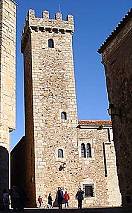 |
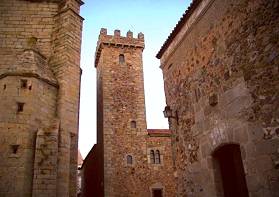 |
|
Caceres, Torre Ciguenas |
was the 2nd Señor of the
House
de las Cigüeñas, at the
Plaza de San Mateus of
Cáceres,
in which he succeeded in 1487, Corregedor of
Valladolid,
Comendador-Mayor of
Alcántara,
in which conventual church he was interred.
Ancestors of Diego de
Cáceres y Ovando and Fray Nicolás de Ovando y Cáceres were:
Juan
Blázquez de Cáceres,
http://en.wikipedia.org/wiki/Juan_Bl%C3%A1zquez_de_C%C3%A1ceres,
the Conqueror of Cáceres, who was a Spanish
soldier and nobleman. Juan Blázquez de Cáceres was born in
Ávila and was at the Conquest of Cáceres (from the
Arabs), on April 23, 1229, from which he took his
surname. He was married to Teresa Alfón and
- had at least one son, Blazco Múñoz de Cáceres,
who died at 90 years and lived in
Cáceres
in 1270,
married to Pascuala Pérez, daughter of
Pascual Pérez and wife Menga Marín,
- parents of Blazco Múñoz de Cáceres,
Founder
and 1st Lord of the Majorat of the same name, and
García Blázquez de Cáceres, who by
one Marina Pérez had
Fernán Blázquez de Cáceres,
2nd
Lord
of the
Majorat
de Blazco Múñoz. They
were the ancestors
of the Marqueses de
Alcántara
(de Villavicencio del
Cuervo, May 13,
1667).[1]
Spanish conquests and expansion in the
Caribbean region
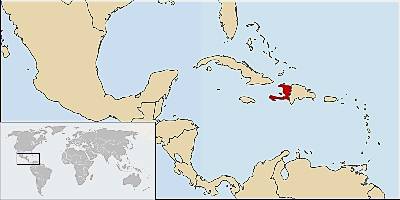
1492 - Colony of Santo Domingo -
http://en.wikipedia.org/wiki/Colony_of_Saint-Domingue
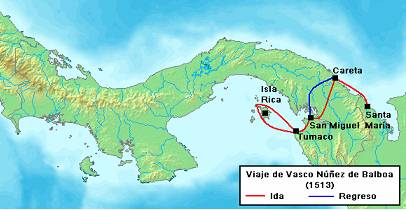
1513
- Balboa's
travel route to the “South Sea” (Pacific Ocean).
Vasco
Núñez de Balboa
(c. 1475 – around January 12–21, 1519[1]),
http://en.wikipedia.org/wiki/Vasco_N%C3%BA%C3%B1ez_de_Balboa
- was a
Spanish
explorer,
governor,
and
conquistador.
In September 1510, he founded the first permanent
settlement on mainland American soil, and called it
Santa María la Antigua
del Darién. He is best
known for having crossed the
Isthmus of Panama
to the
Pacific Ocean
in 1513, becoming the first European to lead an expedition
to have seen or reached the Pacific from the
New World.
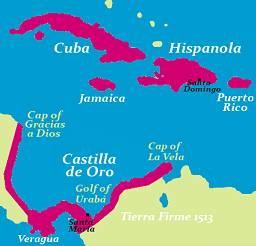
1513 -
Tierra Firme
-
Castilla de Oro
(Colombian-Panamanian border region)
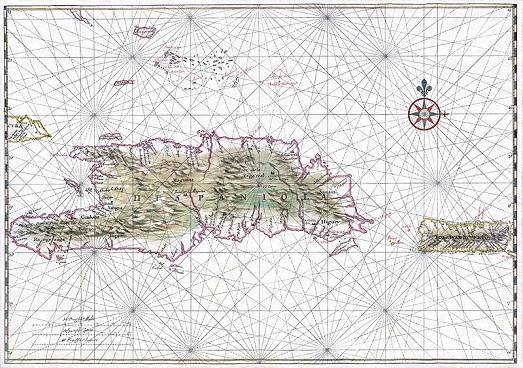
Early map of Hispaniola and
Puerto Rico,
c. 1639.
Gonzalo Fernández de Oviedo
and de las Casas documented that the island was called
Haití ("Mountainous Land") by the Taíno.
Taino Indians -
http://en.wikipedia.org/wiki/Ta%C3%ADno_people
Many
people identify as descendants of the Taíno, most
notably among the
Puerto Ricans
and Dominicans, both on the islands and on the
United States
mainland. The concept of "living Taíno" has proved
controversial. The people and society were long declared
extinct.[52]
The Taíno were seafaring
indigenous peoples
of the
Bahamas,
Greater Antilles,
and the northern
Lesser Antilles.
They were one of the
Arawak peoples
of
South America,[1]
and the
Taíno language
was a member of the
Arawakan
language family
of northern South America.
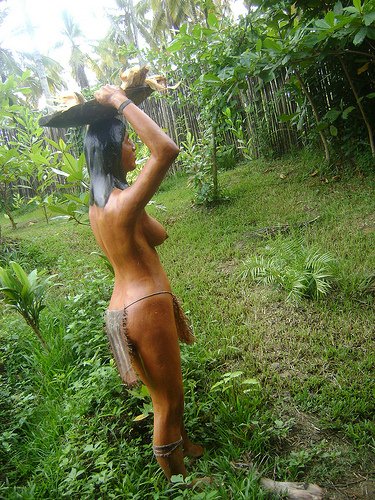
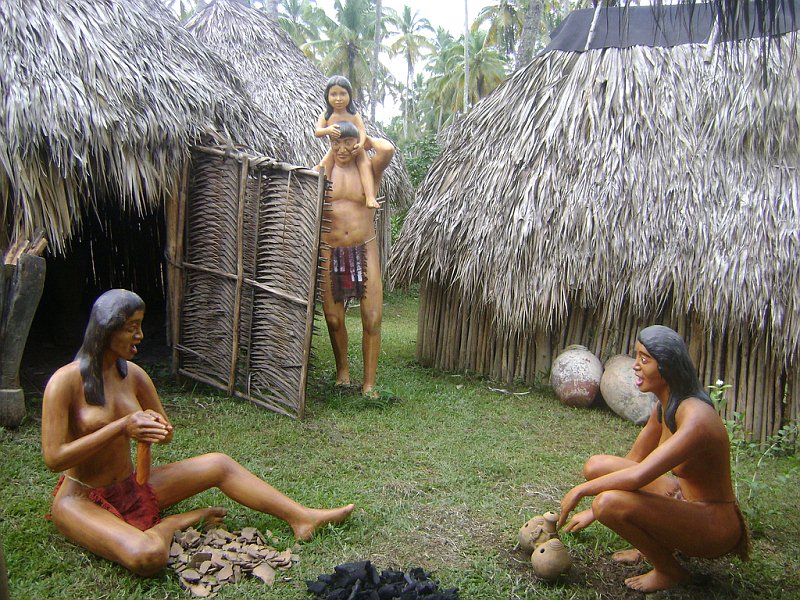
At the
time of
Columbus'
arrival in 1492, there were five Taíno
chiefdoms
and territories on
Hispaniola
(modern-day
Haiti
and
Dominican Republic),
each led by a principal
Cacique
(chieftain),
to whom tribute was paid.At the time of Columbus'
arrival in 1492, there were five Taíno chiefdoms and
territories on Hispaniola (modern-day Haiti and
Dominican Republic), each led by a principal Cacique
(chieftain), to whom tribute was paid.
The
five caciquedoms of Hispaniola at the time of the
arrival of Christopher Columbus. -
http://en.wikipedia.org/wiki/History_of_Haiti

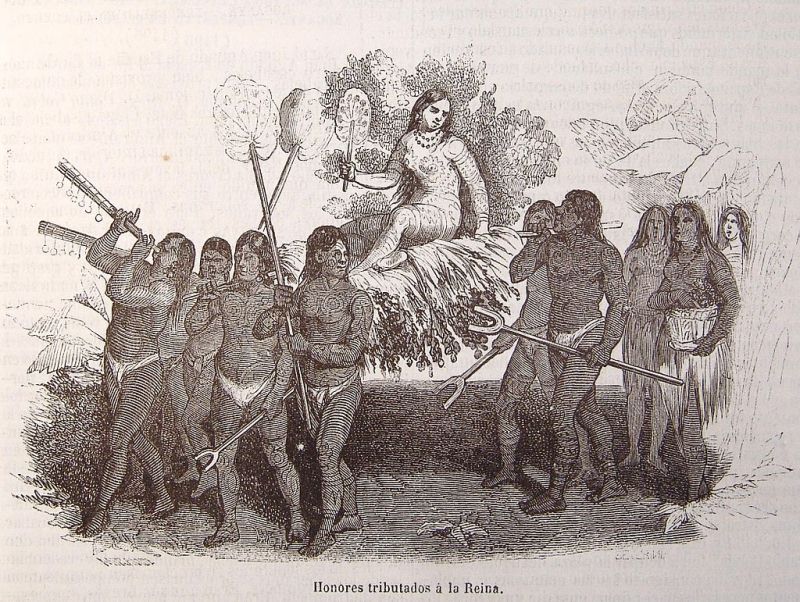
Taino Queen (”caciqua”), called
Anacaona, “The Golden Flower”, at the time of Spanish
arrival in Hispaniola
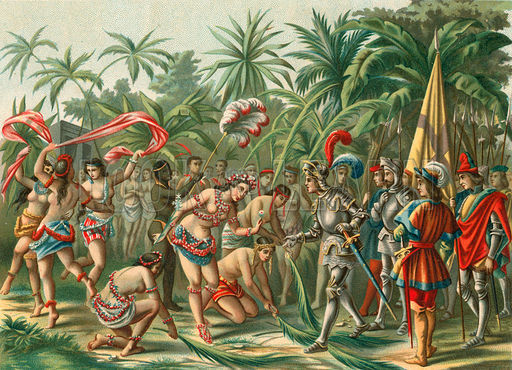
Reception from Anacaona on
Hispaniola for Bartolomew Columbus and his party
Cuba,
the largest island on the
Antilles,
was originally divided into 29 chiefdoms. Most of the
native settlements later became the site of Spanish
colonial cities retaining the original Taíno names, for
instance;
Havana,
Batabanó,
Camagüey,
Baracoa
and
Bayamo.[2]
Puerto Rico
also was divided into
chiefdoms. As the hereditary head chief of Taíno tribes,
the cacique was paid significant tribute. At the time of
the
Spanish conquest,
the largest Taíno population centers may have contained
over 3,000 people each (…)
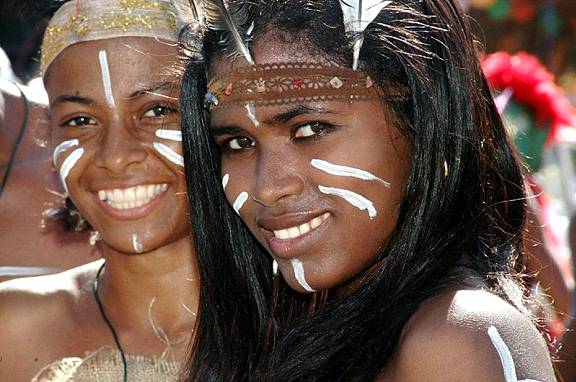
Dominican
girls at carnival, in Taíno garments and makeup (2005)
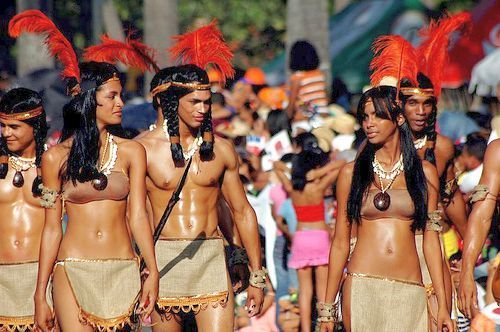
The Taíno were
historically enemies of the neighboring
Carib
tribes, another group with origins in
South America,
who lived principally in the
Lesser Antilles.[3]
Frank Moya Pons, a
Dominican historian, documented that Spanish colonists
intermarried with Taíno women. Over time, some of their
mestizo descendants intermarried with
Africans,
creating a tri-racial
Creole
culture. 1514
census
records reveal that 40% of Spanish men in the Dominican
Republic had Taíno wives.[52]
A 2002 study conducted in
Puerto Rico suggests that over 61% of the population
possess Amerindian mtDNA.[54]
On average Puerto Ricans
possess approximately 10-15%
Native American
MtDNA, most of it Taíno in origin; it is mixed into the
genome
in short pieces, consistent with a single short period
of unions between the races several hundred years ago.[56]
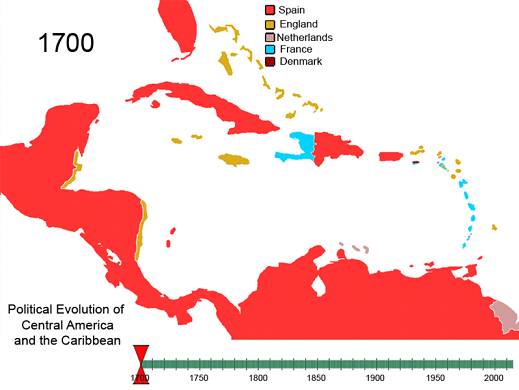
Caribbean 1700 -
http://en.wikipedia.org/wiki/Territorial_evolution_of_the_Caribbean
At the time of the
European
discovery of most of the islands of the Caribbean, three
major
Amerindian
indigenous peoples
lived on the islands: the
Taíno
in the
Greater Antilles,
The Bahamas
and the Leeward Islands; the Island
Caribs
and
Galibi
in the
Windward Islands;
and the
Ciboney
in western
Cuba.
The Taínos are subdivided into Classic Taínos, who
occupied Hispaniola and Puerto Rico, Western Taínos, who
occupied Cuba, Jamaica, and the Bahamian archipelago,
and the Eastern Taínos, who occupied the Leeward
Islands.[1]
Trinidad
was inhabited by both
Carib speaking
and
Arawak-speaking
groups.
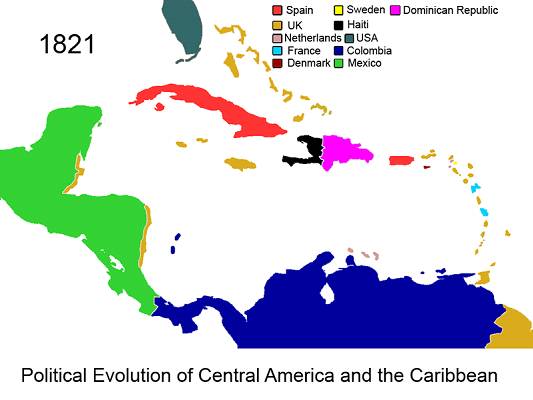
Hispaniola
-
http://en.wikipedia.org/wiki/Hispaniola
(Spanish:
La Española;
Haitian Creole:
Ispayola;
Taíno:
Ayiti[3])
is the
22nd-largest island
in the world, located
in the
Caribbean
island group,
the
Greater Antilles.
It is the second largest island in the
Caribbean
after
Cuba,
the
tenth-most-populous
island in the world, and the most populous in the
Americas.
The island contains two
sovereign nations,
with the
Dominican Republic
occupying the easternmost 64% of the island's area, and
Haiti
the remainder. It is the site of the first European
colonies founded by
Christopher Columbus
on his voyages in 1492 and 1493. The
colonial terms
Saint-Domingue
and
Santo Domingo
are sometimes still applied to the whole island,
although these names refer, respectively, to the
colonies that became Haiti and the Dominican Republic.
Christopher Columbus
arrived at the island during his first voyage to the
Americas in 1492, where his flagship, the
Santa Maria,
sank after running aground on Christmas Day. During his
arrival, he founded the settlement of
La Navidad
on the north coast of present-day
Haiti.
On his return the subsequent year, following the
disbandment of La Navidad, Columbus quickly founded a
second settlement farther east in present-day
Dominican Republic,
La Isabela.
(…) After being destroyed by a
hurricane,
it was rebuilt on the opposite side of the Ozama River
and called
Santo Domingo.
It is the oldest permanent European settlement in the
Americas.
In 1665,
French colonization
of the
island was officially recognized by
King Louis XIV.
The French colony was given
the name
Saint-Domingue.
French Saint-Domingue
-
http://en.wikipedia.org/wiki/History_of_Haiti
- (1625–1789): Its brief history:
The Foundation of a Colony (1625–1711) -
Under the 1697
Treaty of Ryswick,
Spain officially ceded the western third of Hispaniola
to France which renamed the colony
Saint-Domingue.
Saint-Domingue
quickly came to overshadow the east in both
wealth
and
population.
“The
Pearl of the Antilles” (1711–1789) -
one of the richest colonies in the 18th century
French empire.
An estimated 790,000 African slaves (accounting in
1783–91 for a third of the entire
Atlantic slave trade)
worked on the sugar and coffee plantations. They
produced about 40 percent of all the sugar and 60
percent of all the coffee consumed in Europe;
Revolutionary period
(1789–1804) – the rising of slaves, extreme cruelty of
war, Napoleon was defeated (1802-1804) -
In a final act of retribution, the remaining French
were slaughtered by Haitian military forces.
One exception
was a military force of
Poles
from the
Polish Legions
that had fought in Napoleon's army. Some of them refused
to fight against blacks, supporting the principles of
liberty; also, a few Poles (around 100) actually joined
the rebels (W³adys³aw
Franciszek Jab³onowski
was one of the Polish generals). Therefore, Poles were
allowed to stay and were spared the fate of other
whites. About 400 of the 5 280 Poles chose this option.
http://haitikiskeyabohio.blogspot.com/2012/12/polish-descendants-in-haiti.html
W³adys³aw Franciszek Jab³onowski
(25 October 1769–29 September 1802) was a
Black
Polish
and
French
general.
http://en.wikipedia.org/wiki/W%C5%82adys%C5%82aw_Franciszek_Jab%C5%82onowski.
He was of mixed ancestry - the illegitimate child of
Maria Dealire, an English aristocrat, and an
unidentified African. He acquired the nickname "Murzynek"-
(“Negrito”).[1]
Maria Dealire's husband, the Polish nobleman Konstanty
Jab³onowski, accepted him as his son. (…) In 1783 he was
admitted to the French military academy at
Brienne-le-Château.
There he was a schoolmate of
Napoleon
and
Davout.
(…) In 1794 he fought in
Tadeusz Koœciuszko's
uprising
against Tsarist Russia. He participated in battles of
Szczekociny,
Warsaw,
Maciejowice,
and at
Praga.
In 1799 he was made General of Brigade of the
Polish legions.[2]
(…) From 1801 he was the leader of
Legia Naddunajska.
He was sent on his own request to
Haiti
in May 1802 (before the decision to send the rest of the
Polish legions). There he worked to put down the
Haitian Revolution.
Jab³onowski died from
yellow fever
on September 29, 1802 in
Jérémie,
Haiti.[2]
He is mentioned in
Adam Mickiewicz's
famous epic poem
Pan Tadeusz
in the context of a veteran of the Polish legions (…)
Haiti
- The name
Haïti
was adopted (in
1801) by Haitian revolutionary
Jean-Jacques Dessalines
as the official name of independent Saint-Domingue, as a
tribute to the Amerindian predecessors. Quisqueya
(from Quizqueia) although used on both sides of
the island is mostly adopted in the Dominican Republic.
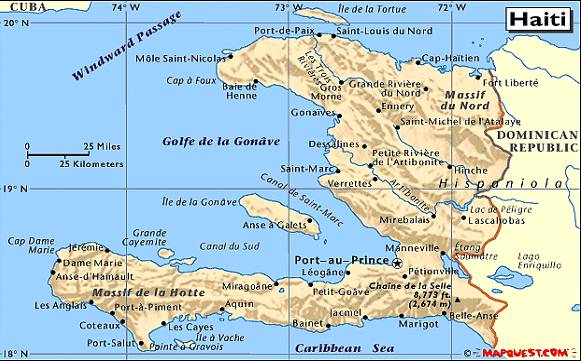
Spanish Hispaniola
-
http://en.wikipedia.org/wiki/History_of_Haiti
-
(1492–1625)
Christopher Columbus
established a settlement,
La Navidad,
near the modern town of
Cap Haitien.
It was built from the timbers of his wrecked ship
Santa María,
during his
first voyage
in December 1492. When he returned in 1493 on his second
voyage he found the settlement had been destroyed and
all 39 settlers killed. Columbus continued east and
founded a new settlement at
La Isabela
on the territory of the present day
Dominican Republic
in 1493. The capital of the colony was moved to
Santo Domingo
in 1496, on the south west coast of the island also in
the territory of the present day Dominican Republic. The
Spanish returned to western Hispaniola in 1502,
establishing a settlement at Yaguana, near modern day
Léogane.
A second settlement was established on the north coast
in 1504 called Puerto Real near modern
Fort Liberte
– which in 1578 was relocated to a nearby site and
renamed Bayaha.
Dominican Republic
-
When the
French Revolution
abolished
slavery in the colonies on February 4, 1794, it was a
European first,[12]
and when Napoleon reimposed slavery in 1802 it
led to a major upheaval by the emancipated black slaves.
(…) After the French removed the surviving 7,000 troops
in late 1803, the leaders of the revolution declared the
new nation of independent Haiti in early 1804.
(…) France demanded a high payment for compensation
to slaveholders who lost their property, and Haiti
was saddled with unmanageable debt for decades.[14]
It became one of the poorest countries in the Americas,
while the Dominican Republic, whose independence was won
via a very different route[14]
gradually has developed into the largest economy of
Central America
and the
Caribbean.
In the second 1795 Treaty of Basel (July 22), Spain
ceded the eastern two-thirds of the island
of Hispaniola, later to become the Dominican
Republic. (…)
Haitian Revolution
-
http://en.wikipedia.org/wiki/Haitian_Revolution
The Haitian Revolution
(1791–1804) was a
slave revolt
in the French
colony
of
Saint-Domingue,
which culminated in the elimination of
slavery
there and the founding of the
Republic of Haiti.
The Haitian Revolution was the only slave revolt which
led to the founding of a
state.
(…) The rebellion began with a revolt of black African
slaves in August 21, 1791. It ended in November 1803
with the French defeat at the
battle of Vertières.
Haiti became an independent country on
January 1, 1804.
Within the next ten days,
slaves had taken control of the entire Northern Province
in an unprecedented slave revolt. Whites kept control of
only a few isolated, fortified camps. The slaves sought
revenge on their masters through "pillage, rape,
torture, mutilation, and death".[23]
Because the plantation owners had long feared such a
revolt, they were well armed and prepared to defend
themselves. Nonetheless, within weeks, the number of
slaves who joined the revolt reached some 100,000.
Within the next two months, as the violence escalated,
the slaves killed 4,000 whites and burned or destroyed
180 sugar plantations and hundreds of coffee and indigo
plantations.[23]
By 1792, slave rebels controlled a third of the island.
Apart from granting
rights to the free people of color, the Assembly
dispatched 6,000 French soldiers to the island.[24]
Meanwhile, in 1793, France
declared war on Great Britain. The white planters in
Saint Domingue made agreements with Great Britain to
declare British sovereignty over the islands. Spain, who
controlled the rest of the island of
Hispaniola,
would also join the conflict and fight with Great
Britain against France. The Spanish forces invaded Saint
Domingue and were joined by the slave forces. (…) the
French commissioners
Sonthonax
and Poverel freed the slaves in St. Domingue. It has
recently been estimated that the slave rebellion
resulted in the death of 350,000 Haitians and 50,000
European troops.[26].
One of the most
successful black commanders was
Toussaint L'Ouverture,
a self-educated former domestic slave. (…) After the
British had invaded Saint-Domingue, L'Ouverture decided
to fight for the French if they would agree to free all
the slaves. He brought his forces over to the French
side in May 1794 and began to fight for the French
Republic. Under the military leadership of Toussaint,
the forces made up mostly of former slaves succeeded in
winning concessions from the British and expelling the
Spanish forces. In the end, Toussaint essentially
restored control of Saint-Domingue to France. Toussaint
defeated a British expeditionary force in 1798. In
addition, he led an invasion of neighboring Santo
Domingo (December 1800), and freed the slaves
there on January 3, 1801. (…)
Napoleon Bonaparte
dispatched a
large expeditionary force
of French soldiers and warships to the island, led by
Bonaparte's brother-in-law
Charles Leclerc,
to restore French rule. (…) L'Ouverture was promised his
freedom if he agreed to integrate his remaining troops
into the French army. L'Ouverture agreed to this in May
1802. He was later deceived, seized by the French and
shipped to France. He died months later in prison at
Fort-de-Joux
in the Jura region.[8]
(…)
On 1 January 1804,
Dessalines,
the new leader under the dictatorial 1801 constitution,
declared Haiti a free republic in the name of the
Haitian people,[32]
which was followed by the
massacre of the remaining whites.[33(…)
Fearing a return of French forces, Dessalines first
expanded and maintained a significant military force.
(…)Under the presidency of
Jean Pierre Boyer,
Haiti made reparations to French slaveholders in 1825 in
the amount of 150 million francs, reduced in 1838 to
60 million francs, in exchange for French recognition of
its independence. (…) Haitian forces, led by Boyer,
invaded neighboring
Dominican Republic
in February 1822. This was the beginning of a 22-year
occupation by Haitian forces.[40]
(...)
After three centuries of
Spanish rule, with French and Haitian interludes, the
country became independent in 1821. The ruler,
José Núñez de Cáceres,
intended that the Dominican Republic be part of the
nation of
Gran Colombia,
but he was quickly removed by the Haitian government and
"Dominican" slave revolts. Victorious in the
Dominican War of Independence
in 1844, Dominicans experienced mostly
internal strife
over the next 72 years, and also a brief return to
Spanish rule. (…)
Unification of Hispaniola
-
http://en.wikipedia.org/wiki/Unification_of_Hispaniola
European colonization
- By
the late 18th century, the island of
Hispaniola
had been divided into two European colonies:
Saint-Domingue,
in the west, governed by France; and
Santo Domingo,
governed by Spain, occupying the eastern five-eighths of
Hispaniola.
In 1804, following black
slave uprisings since 1791, the French colony
declared its
independence as
Haïti. Independence did not come easily, given the
fact that Haiti had been France's most profitable
colony, and the richest in the hemisphere. The colony
was dubbed the Pearl of the Antilles, as a result
of the sugar plantations worked by slaves; sugar had
become a very expensive commodity in Europe.[4]
Meanwhile, on the eastern
side, what was once the
headquarters
of Spanish colonial power in the
New World
historically had fallen into decline. At the time, Spain
had most of its own resources focused on the
Peninsular War
and the various hard-fought
wars to maintain
control of the American mainland.[5]
The economy of Santo Domingo
was stalled, the land largely
unexploited and used for
sustenance farming
and
cattle ranching,
and the population was much lower than in Haiti. The
accounts by the Dominican essayist and politician
José Núñez de
Cáceres cite the
Spanish colony's population at around 80,000, mainly
composed of
European
descendants, mulattos, freedmen, and a few black slaves.
Haiti, on the other hand, was nearing a million former
slaves.
Independence from Spain
- On November 9,
1821 the Spanish colony of Santo Domingo was
toppled by a group led by
José Núñez de
Cáceres, the
colony's former administrator,[6][7]
and the rebels proclaimed independence from the Spanish
crown on November 30, 1821.[8]
The new nation was known as Republic of Spanish Haiti
(Spanish: República del Haití Español), as
Haiti had been the indigenous name of the island.[7]
On December 1, 1821 a constitutive act was ordered to
petition the union of Spanish Haiti with
Gran Colombia.
A group of Dominican
politicians and military officers favored uniting the
newly independent nation with Haiti, as they
sought for political stability under Haitian president
Jean Pierre Boyer,
and were attracted to Haiti's perceived wealth and power
at the time. A large faction based in the northern
Cibao
region were opposed to the union with Gran Colombia and
also sided with Haiti. Boyer, on the other hand, had
several objectives in the island that he proclaimed to
be "one and indivisible": to maintain Haitian
independence against potential French or Spanish attack
or reconquest; to maintain the freedom of its former
slaves; and to liberate the remaining slave minority on
the Dominican side of the island.[8][9][10]
While appeasing the
Dominicans, Jean Pierre Boyer was already in
negotiations with France to prevent an attack by
fourteen French warships stationed near
Port-au-Prince,
the Haitian capital. They soon agreed that France would
sell the territory to the Haitian rebels for 150 million
Francs (more than twice what France had charged the
United States for the much larger
Louisiana territory
in 1803).
The Dominican
nationalists who were against the unification of the
island were at a serious disadvantage if they were to
prevent this from occurring. At the time, they had no
trained military forces whatsoever. The population was
eight to ten times less than Haiti's, and the economy
was stalled. Haiti, on the other hand, had formidable
armed forces, both in skill and sheer size, which had
been hardened in nearly ten years of repelling French
Napoleonic soldiers,
and British soldiers, along with the local colonialists,
and military insurgents within the country. The racial
massacres perpetrated in the later days of the
French–Haitian conflict only added to the determination
of Haitians to never lose a battle.
Unification
- After promising his full support to several Dominican
frontier governors and securing their allegiance, Boyer
entered the country with around 10,000 soldiers in
February 1822, encountering little to no opposition. On
February 9, 1822, Boyer formally entered the capital
city, Santo Domingo after its ephemeral independence ,
where he was met with great enthusiasm and received from
president Núñez de Cáceres the keys to the Palace.[9]
The island was thus united from "Cape Tiburon to Cape
Samana in possession of one government."[8]
The occupation is
recalled by some as a period of strict military rule,
though the reality was far more complex. It led to
large-scale land
expropriations and failed efforts to force
production of export crops, impose military services,
restrict the use of the Spanish language, and
suppress traditional customs. The 22 year
unification reinforced the
Spanish Haitian
people perception of
themselves as different from the
Haitians
in race, language, religion and domestic customs.[1]
This period also definitively ended slavery as an
institution in what became the
Dominican Republic,
though ironically
forms of slavery
still remain an integral part of Haitian culture.[2][3]
In order to raise funds
for the huge indemnity of 150 million francs that Haiti
agreed to pay the former French colonists, and which was
subsequently lowered to 60 million francs, Haiti imposed
heavy taxes on the Dominicans. Since Haiti was unable to
adequately provision its army, the occupying forces
largely survived by commandeering or confiscating food
and supplies at gunpoint. Attempts to
redistribute
land conflicted with the system of communal land tenure
(terrenos comuneros), which had arisen with the
ranching economy, and newly emancipated slaves resented
being forced to grow cash crops under Boyer's Code
Rural.[11]
In rural areas, the Haitian administration was usually
too inefficient to enforce its own laws. It was in the
city of Santo Domingo that the effects of the occupation
were most acutely felt, and it was there that the
movement for independence originated.
Haiti's constitution also forbade white elites from
owning land, and the major landowning families
were forcibly deprived of their properties. Most
emigrated
to
Cuba,
Puerto Rico
(these two being
Spanish possessions
at the time) or
Gran Colombia,
usually with the encouragement of Haitian officials, who
acquired their lands. The Haitians, who associated the
Roman Catholic
Church with the French
slave-masters who had exploited them before
independence, confiscated all church property, deported
all foreign clergy, and severed the ties of the
remaining clergy to the
Vatican.
Santo Domingo's
university, the oldest
in the
Western Hemisphere,
lacking both students and teachers had to close down,
and thus the country suffered from a massive case of
human capital flight.
Although the occupation effectively eliminated colonial
slavery and instated a constitution modeled after the
United States
Constitution
throughout the island, several resolutions and written
dispositions were expressly aimed at converting average
Dominicans into second-class citizens: restrictions of
movement, prohibition to run for public office, night
curfews, inability to travel in groups, banning of
civilian organizations, and the indefinite closure of
the state university (on the alleged grounds of its
being a subversive organization) all led to the creation
of movements advocating a forceful separation from Haiti
with no compromises.
Resistance
- In 1838 a
group of educated nationalists, among them,
Juan Pablo Duarte,
Matías Ramón Mella,
and
Francisco del
Rosario Sánchez
founded a secret society called
La Trinitaria
to gain independence from Haiti. In 1843 they allied
with a Haitian movement that overthrew Boyer in Haiti.
After they revealed themselves as revolutionaries
working for Dominican independence, the new Haitian
president,
Charles
Rivière-Hérard, exiled
or imprisoned the leading Trinitarios. At the
same time,
Buenaventura Báez,
an
Azua
mahogany exporter and deputy in the
Haitian National
Assembly, was
negotiating with the French Consul-General for the
establishment of a French protectorate.
In an uprising timed to
preempt Báez, on February 27, 1844, the Trinitarios
declared independence from Haiti, backed by
Pedro Santana,
a wealthy cattle-rancher from
El Seibo
who commanded a private army of
peons
who worked on his estates. This marked the beginning of
the
Dominican War of
Independence.
The
Unification of Hispaniola
by Haiti lasted twenty-two years, from February 9,
1822 to February 27, 1844. This unification
ended the first brief period of independence in
the nation's history,
the
Republic of Spanish
Haiti, which had been
known as the
Captaincy General of Santo Domingo.
Dominican War of Independence -
http://en.wikipedia.org/wiki/Dominican_War_of_Independence
The Dominican Independence War gave the
Dominican Republic
freedom from
Haiti
on February 27, 1844. Before the war, the island
of
Hispaniola
had been unified under Haitian rule for a period of 22
years when Haiti
occupied the independent state of Spanish Haiti
in 1822. After the struggles that were made by
Dominican
nationalists to free the country from Haitian control,
they had to withstand and fight against a series of
Haitian incursions that served to consolidate their
independence (1844-1856). After the war Haitian soldiers
would make incessant attacks to try to gain back control
of the nation, but these efforts were to no avail, as
the Dominicans would go on to decisively win every
battle.
Cáceres
– Criollos born in Hispaniola/Dominican Republic
http://en.wikipedia.org/wiki/Dominican_Republic
The Criollo
(or "creole" people)
http://en.wikipedia.org/wiki/Criollo_people)
were a social class in the
caste system
of the
overseas colonies established by Spain
in the 16th century, especially in
Latin America,
comprising the locally born people of pure
Spanish
ancestry.[1]
The
Criollo class ranked below that of the Iberian
Peninsulares,
the high-born (yet class of commoners) permanently
resident colonists born in
Spain.
But Criollos were higher status/rank than all other
castes — people of mixed descent, Amerindians, and
enslaved
Africans.
According to the
casta
system, a Criollo could have up to 1/8 (one
great-grandparent or equivalent)
Amerindian,
ancestry and not lose social place (see
Limpieza de sangre).[2]
In the 18th- and early 19th centuries, changes in the
Spanish Empire's policies towards her colonies (and
their polyglot of peoples) led to tensions between the
Criollos and the Peninsulares.[citation
needed]
The growth of local Criollo political and economic
strength in their separate colonies coupled with their
global geographic distribution, and led them to each
evolve a separate (both from each other and Spain)
organic national personality and viewpoint. Criollos
were the main supporters of the
Spanish American wars of independence.
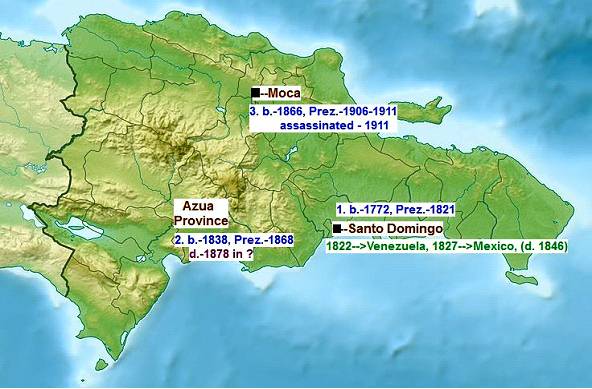
Map of the Dominican Republic
– indicated are dates and places of births (b.)
and deaths (d.) of the prominent Caceres
personalities listed below
(...)
After three centuries of Spanish rule,
with French and Haitian interludes, the country became
independent in 1821. The ruler,
José Núñez de Cáceres,
intended that the Dominican Republic be part of the
nation of
Gran Colombia,
but he was quickly removed by the Haitian government and
"Dominican" slave revolts. Victorious in the
Dominican War of Independence
in 1844, Dominicans experienced mostly
internal strife
over the next 72 years, and also a brief return to
Spanish rule. (…)
|

President of
Spanish Haiti,
December 31, 1821 – February 9,
1821
|
1) José Núñez de Cáceres Albor
–
born in [the city of] Santo
Domingo in 1772/1779? President in 1821.
http://en.wikipedia.org/wiki/Jos%C3%A9_N%C3%BA%C3%B1ez_de_C%C3%A1ceres
(This name uses
Spanish
naming customs;
the first or paternal
family
name is
Núñez de Cáceres and
the second or maternal family name is Albor).
José
Núñez de Cáceres
-
http://en.wikipedia.org/w/index.php?title=Special:Search&limit=50&offset=50&redirs=1&profile=default&search=Ramon+C%C3%A1ceres
José Núñez de Cáceres Albor (b.
Santo Domingo,
March 14, 1772/1779; †
Ciudad Victoria
(Mexico),
September 11, 1846) was a Dominican
politician and writer. He was the leader of
Dominican independence when
Spain
ruled the country and he was also the first
person in the country to use literature as
weapon of social protest and politics. He was
also the first Dominican
fabulist
and one of the first
criollo
storytellers in
Spanish America.
In addition, he founded the newspaper "El Duende",
the second newspaper created in Santo Domingo.
José Núñez de
Cáceres Albor was born on March 14, 1772 (or
1779), in Santo Domingo. He was the
son of
2ndLt. Francisco
Núñez de Cáceres and María Albor.
His mother died a few days after his birth. He
was raised by his aunt María Núñez de Cáceres.
Since his childhood, Núñez de Cáceres showed
great love for his education but his father was
a farmer and wanted his son to dedicate himself
to also working the field. Núñez de Cáceres was
raised in a very poor family. He had to study
using the books of his classmates because he did
not have all the books he needed. He earned some
money helping his aunt sell the doves that an
acquaintance hunted. Despite early obstacles, at
age 23, in 1795, Nuñez de Cáceres got the Civil
Law degree, he formed a distinguished clientele,
and he became a professor at the
University of Santo Tomás de
Aquino.[1]
At the end of the 18th century
Núñez de Cáceres married Juana de Mata Madrigal
Cordero and they had six(?) children:
1/ the first, Pedro, was
born in Santo Domingo on April 2, 1800,
5/ and last, Maria de la Merced, in the
same city, (Santo Domingo) in
1816
When Ñúñez de Cáceres lived in
Camagüey,
Cuba,
other three children were born:
2/ José, the September 9, 1804;
3/ Francisco de Asis, 15 September
1805, and
4/ Gregorio, on June 8, 1809.
[1] |
|
 |
|
|
 |
3) Ramón Arturo Cáceres
Vasquez
(15
December 1866,
Moca,
Dominican Republic
– 19 November 1911,
Santo
Domingo)
http://en.wikipedia.org/wiki/Special:Search/Ramon_C%C3%A1ceres
-
was the –
Vice
President
under
Carlos
Felipe Morales,
24 November 1903 - 29 December 1905
31st
President of the Dominican Republic
- (1906
– 1911). Cáceres assumed the office in 1906
and was assassinated in 1911,
ambushed by rebels and killed in his car.[1]
Cáceres was the
leader of the
Los Coludos,
also named Red Party.[2]
http://en.wikipedia.org/wiki/Ram%C3%B3n_C%C3%A1ceres.
His death was followed by
general disorder and, ultimately, by the U.S.
occupation of the Dominican Republic in 1916.[3][4]
http://en.wikipedia.org/wiki/History_of_the_Dominican_Republic
In 1906, (Prez.)
Morales resigned, and Horacista vice-president
Ramon
Cáceres became
President. After suppressing a rebellion in the
northwest by Jimenista General
Desiderio
Arias, his
government brought political stability and
renewed economic growth, aided by new American
investment in sugar industry. However, his
assassination in 1911, for which Morales and
Arias were at least indirectly responsible, once
again plunged the republic into chaos. For two
months, executive power was held by a civilian
junta dominated by the chief of the army,
General
Alfredo
Victoria. The
surplus of more than 4 million pesos left by
Cáceres was quickly spent to suppress a series
of insurrections.[20]New
York Times
article -
http://query.nytimes.com/mem/archive-free/pdf?res=9502EED61030E333A25754C2A9619C94689ED7CF |
Special Internet search for
the name Caceres
Caceres
was (also) the name of a Jewish family, members of which
lived in
Portugal,
the
Netherlands,
England,
Mexico,
Suriname,
the
West Indies,
and the
United States.
They came from the city of
Cáceres
in Spain.
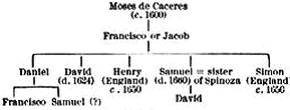
Descendants of Moseh de Caceres
G. A. Kohut, Simon de Caceres and His
Plan for the Conquest of Chili, New York, 1899 (reprinted
from the American Hebrew, June 16, 1899).
Name
Cáceres
in other countries of Latin America
(16th – 19th century)
1) Alonso de Cáceres y Retes
– a conquistador,
http://en.wikipedia.org/wiki/Alonso_de_C%C3%A1ceres
- (born in
Alcántara,
Cáceres,
late fifteenth century - ?) was a ruthless Spanish
conquistador and governor-captain of Santa Marta,[1]
who despite his prolonged military nomadism throughout
the American geography (from
Mexico
to
Peru,
including
Central America),
and his important conquering and peacekeeping ideas, can
be considered one of the most active soldiers who served
in the sixteenth-century Spanish process of conquest.[2]
He was born in the
village of Alcántara (Cáceres), in the late
fifteenth century. He was the son of Gregorio and
Maria Cáceres Retes, had military training and took
part in military interventions in other parts of the old
continent, but his first performances in the American
conquest was exercised after 1530, as a captain
under the command of Governor
Pedro de Heredia,
in southern
Panama
and northern
Colombia,
participating in the foundation of the Colombian city of
Cartagena
de Indias and subsequent interventions as explorer and
conqueror were performed on the
Isthmus of Panama
and on the border Colombia.
On 21 October 1534,
Pedro de Heredia forces under Captain Alonso de Cáceres
command, seized
Acla
and took prisoners for Julián Gutiérre and his wife, the
native Isabel, who knew Spanish and whom Heredia needed
to reach agreement with the Urabá people.
As a man of remarkable
ability, whatever it had been in addition to his
military occupations, he was required for the
administration or the government of the cities where he
lived temporarily. In Santa Marta (Colombia), he served
as
alderman,
in
Yucatan
he served as lieutenant for Francisco de Montejo and
replaced him in the office of
head chief
whenever Montejo was called away, in Arequipa (Peru) he
was appointed mayor and presumably ended his days in
Arequipa enjoying deserved parcels awarded to him.
He married in Lima with
native
creole
María de Solier y Valenzuela, from whose union he had a
son named Diego de Cáceres and Solier, who
married María Mauricia de Ulloa y Angulo in 1581,[3]
from whose union he became grandfather to José de
Cáceres y Ulloa.[4]
Petronila de Cáceres and
Solier,
who first married contrajo matrimonio con Sebastián de
Casalla in 1568 and to Rodrigo de Esquivel y Zúñiga,
whose offspring brought him the marquisate of San
Lorenzo del Valleumbroso.
2)
Francisco Antonio de
Cáceres Molinedo
– Spanish
Governor of Nicaragua
– 1745
http://en.wikipedia.org/wiki/List_of_Governors_in_the_Viceroyalty_of_New_Spain
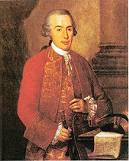 3)
Luís de
Albuquerque de Melo Pereira e Cáceres,
Governador
de Mato Grosso
1772 — 1789,
(Ladário,
21 de outubro
de
1739
—
7 de julho
de
1797)
foi um
militar e
administrador colonial
português. Foi o
quarto governador e capitão-general da
capitania de Mato Grosso
(Brasil).
Tendo tomado posse em 13 de dezembro de 1772,
exerceu o cargo até 1789, sendo sucedido por seu
irmão,
João de Albuquerque de Melo
Pereira e Cáceres. 3)
Luís de
Albuquerque de Melo Pereira e Cáceres,
Governador
de Mato Grosso
1772 — 1789,
(Ladário,
21 de outubro
de
1739
—
7 de julho
de
1797)
foi um
militar e
administrador colonial
português. Foi o
quarto governador e capitão-general da
capitania de Mato Grosso
(Brasil).
Tendo tomado posse em 13 de dezembro de 1772,
exerceu o cargo até 1789, sendo sucedido por seu
irmão,
João de Albuquerque de Melo
Pereira e Cáceres.
http://pt.wikipedia.org/wiki/Lu%C3%ADs_de_Albuquerque_de_Melo_Pereira_e_C%C3%A1ceres
-
Durante o seu governo foram erguidos o
Forte de Coimbra
e o
Real Forte Príncipe da Beira,
e fundadas Albuquerque (atual cidade de
Corumbá),
Ladário
(em homenagem à sua terra natal em Viseu), Vila Maria
(atual
Cáceres),
Casalvasco (atual
Vila Bela da Santíssima
Trindade),
Salinas
e
Corixa Grande,
consolidando o domínio português na região diante dos
domínios da Coroa espanhola na América.
4) María Luisa Cáceres Díaz de Arismendi
– (born in Venezuela in 1799, heroine of the War
of Independence) (September 25, 1799 – June 28,
1866) was a heroine of the
Venezuelan War of
Independence. Luisa
was born in Caracas, Venezuela, to José Domingo
Cáceres and Carmen Díaz, prosperous
Criollos.
On her father's side, she was of
Canarian
descent.
http://en.wikipedia.org/wiki/Luisa_C%C3%A1ceres_de_Arismendi.
 5)
José Bernardo Cáceres
-
Battle of Maipu
http://en.wikipedia.org/wiki/Battle_of_Maipu_order_of_battle,
“Patriots” - United Army
Commander: General
José de San
Martín
Commanding officer
of the
2nd Infantry Battalion
- Alvarado'
Division
(Colonel Alvarado),
The
Battle of Maipú
(Spanish: Batalla de Maipú) was a battle fought near
Santiago,
Chile
on April 5, 1818 between
Patriots
and
Royalists,
during the
Spanish American
Wars of Independence.
The Patriots led by José de San Martín effectively
destroyed the Spanish Royalist forces commanded by
General Mariano Osorio, and won the independence of
Chile. 5)
José Bernardo Cáceres
-
Battle of Maipu
http://en.wikipedia.org/wiki/Battle_of_Maipu_order_of_battle,
“Patriots” - United Army
Commander: General
José de San
Martín
Commanding officer
of the
2nd Infantry Battalion
- Alvarado'
Division
(Colonel Alvarado),
The
Battle of Maipú
(Spanish: Batalla de Maipú) was a battle fought near
Santiago,
Chile
on April 5, 1818 between
Patriots
and
Royalists,
during the
Spanish American
Wars of Independence.
The Patriots led by José de San Martín effectively
destroyed the Spanish Royalist forces commanded by
General Mariano Osorio, and won the independence of
Chile.
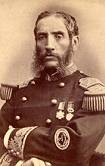 6)
Andrés Avelino Cáceres Dorregaray
– President of Peru (x3) – 1883-1885, 1886-1890,
1894-1895
http://en.wikipedia.org/wiki/Andr%C3%A9s_Avelino_C%C3%A1ceres.
Andrés
Avelino Cáceres Dorregaray
(November 10, 1836 – October 10, 1923) was
three times
President of Peru
during the 19th century, from 1884 to 1885, then
from 1886 to 1890, and again from 1894 to 1895.
In Peru, he is considered a national hero for leading
the resistance to
Chilean
occupation during the
War of the Pacific
(1879–1883), where he fought as a
General
in the
Peruvian Army.
Andrés Avelino Cáceres was born on November 10, 1836, in
the city of
Ayacucho.[2]
His father, Don Domingo Cáceres y Ore, was a
landowner
and his mother, Justa Dorregaray Cueva, daughter of the
Spanish colonel Demetrio Dorregaray. He was
mestizo;
one of his maternal ancestors was Catalina Wanka, an
Incaica-Wanka princess. He studied at the Colegio San
Ramón (Spanish:
San Ramón School)
in his hometown. 6)
Andrés Avelino Cáceres Dorregaray
– President of Peru (x3) – 1883-1885, 1886-1890,
1894-1895
http://en.wikipedia.org/wiki/Andr%C3%A9s_Avelino_C%C3%A1ceres.
Andrés
Avelino Cáceres Dorregaray
(November 10, 1836 – October 10, 1923) was
three times
President of Peru
during the 19th century, from 1884 to 1885, then
from 1886 to 1890, and again from 1894 to 1895.
In Peru, he is considered a national hero for leading
the resistance to
Chilean
occupation during the
War of the Pacific
(1879–1883), where he fought as a
General
in the
Peruvian Army.
Andrés Avelino Cáceres was born on November 10, 1836, in
the city of
Ayacucho.[2]
His father, Don Domingo Cáceres y Ore, was a
landowner
and his mother, Justa Dorregaray Cueva, daughter of the
Spanish colonel Demetrio Dorregaray. He was
mestizo;
one of his maternal ancestors was Catalina Wanka, an
Incaica-Wanka princess. He studied at the Colegio San
Ramón (Spanish:
San Ramón School)
in his hometown.
7) Luis Caceres -
The
Governor
of the
Argentine
province
of
Córdoba,
which is the highest executive
officer of the province-
http://en.wikipedia.org/wiki/Governor_of_C%C3%B3rdoba
Name Cáceres
in Latin America
– Contemporary, prominent politicians
1)
Ramón Cáceres Troncoso
–
1964, Council of
State (Triumvirate) of the Dominican Republic
http://en.wikipedia.org/wiki/Ram%C3%B3n_Tapia_Espinal
–
Ramón Tapia Espinal was a
member of the Council of State (1961-1963) which
succeeded the overthrow of the dictator
Rafael Leónidas
Trujillo in 1961.[1]
He later served as a member of the triumvirate, a
three-man civilian executive committee, established by
the military after the overthrow of President
Juan Bosch
in 1963; originally with
Emilio de los Santos
and
Manuel Enrique
Tavares Espaillat, and
later with
Donald Reid Cabral
and
Manquel Enrique
Tavares Espaillat.[2]
He resigned from the triumvirate in 1964 and was
succeeded by
Ramón Cáceres
Troncoso.[3]
2) Eduardo Cáceres
– Vice President of Guatemala,
http://en.wikipedia.org/wiki/Eduardo_C%C3%A1ceres
-
Eduardo Rafael Cáceres Lehnhoff
served as
Vice President of Guatemala
from 1 July 1970 to 1 July 1974 in the
cabinet of
Carlos Arana.
Died 31 January 1980 in the
Burning of the Spanish Embassy
in Guatemala-City[1]
3)
Marina Isabel Caceres de Estevez
– 2008, Dominican Republic, Ambassador
to Denmark, Sweden and Finland - Non-resident Heads of
Missions -
http://en.wikipedia.org/wiki/List_of_heads_of_missions_from_the_Dominican_Republic
4) Félipe Caceres
– Bolivia, Vice Minister of Social Defense
in the government of Juan Evo Morales (the presidential
candidate of MAS-IPSP - Movement for Socialism -
Political Instrument for the Sovereignty of the Peoples
- a
Bolivian
political movement led by
Evo Morales),
after he won the general election in 2005.
http://en.wikipedia.org/wiki/Movement_for_Socialism_%E2%80
93_Political_Instrument_for_the_Sovereignty_of_the_Peoples.
Since taking office, the MAS-IPSP government has
emphasized modernization of the country, promoting
industrialization, increasing state intervention in the
economy, promoting social and cultural inclusion, and
redistribution of revenue from natural resources
through various social service programs.[32]
MAS-IPSP evolved out of
the movement to defend the interests of
coca
growers. Evo Morales has articulated the goals of his
party and popular organizations as the need to achieve
pluri-national unity, and to develop a new
hydrocarbon
law which guarantees 50% of revenue to Bolivia, although
political leaders of MAS-IPSP recently interviewed
showed interest in complete
nationalization
of the
fossil fuel
industries.
Puerto Rico
http://en.wikipedia.org/wiki/Puerto_Rico
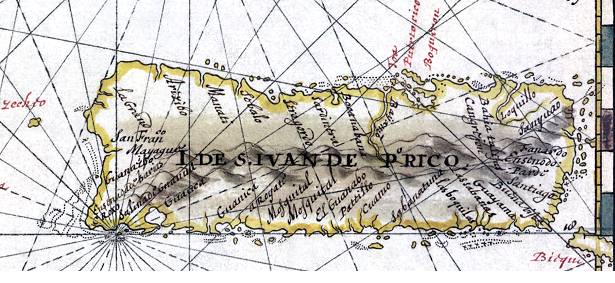
Map of Puerto Rico in 1639
When Columbus arrived in
Puerto Rico during his second voyage on November 19,
1493, the island was inhabited by the Taíno. They
called it Borikén (Borinquen in Spanish
transliteration).[h]
Columbus named the island San Juan Bautista, in honor of
the Catholic saint,
John the Baptist.
Juan Ponce de León,
a
lieutenant
under Columbus, founded the first Spanish settlement,
Caparra,
on August 8, 1508. (Caparra is an
archaeological site
in the municipality of
Guaynabo, Puerto Rico.)
In the beginning of the 16th century, the
Spaniards
began to colonize the island. (…) During the late 17th
and early 18th centuries, Spain concentrated its
colonial efforts on the more prosperous mainland North,
Central, and South American colonies. The island of
Puerto Rico was left virtually unexplored, undeveloped,
and (excepting coastal outposts) largely unsettled
before the 19th century. (…)
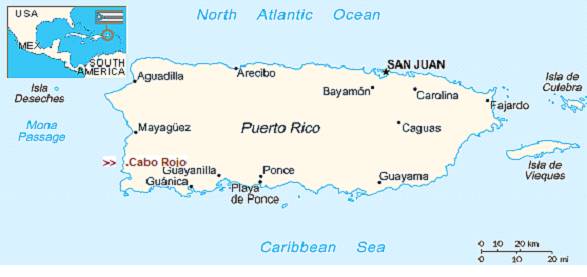
http://en.wikipedia.org/wiki/History_of_Puerto_Rico
In 1809, to secure its political bond
with the island and in the midst of the European
Peninsular War,
the
Supreme Central Junta
based in
Cádiz
recognized Puerto Rico as an overseas province of Spain.
It gave the island residents the right to elect
representatives to the recently convened
Spanish parliament
(Cádiz Cortes), with equal representation to mainland
Iberian, Mediterranean (Balearic Islands) and Atlantic
maritime Spanish provinces (Canary Islands).
Ramon Power y Giralt,
the first Spanish parliamentary representative from the
island of Puerto Rico, died after serving a three-year
term in the Cortes. These
parliamentary and constitutional reforms
were in force from 1810 to 1814, and again from 1820 to
1823. They were twice reversed during the restoration of
the traditional monarchy by
Ferdinand VII.
Nineteenth century immigration and commercial trade
reforms increased the island's ethnic European
population and economy, and expanded Spanish cultural
and social imprint on the local character of the island.
(…)
In the early 19th
century, Puerto Rico had an independence movement which,
due to the harsh persecution by the Spanish authorities,
met in the island of St. Thomas. The movement was
largely inspired by the ideals of
Simón Bolívar
in establishing a
United Provinces of New Granada,
which included Puerto Rico and Cuba. Among the
influential members of this movement were Brigadier
General
Antonio Valero de Bernabe
and
María de las Mercedes Barbudo.
The movement was discovered and Governor
Miguel de la Torre
had its members imprisoned or exiled.
Hurricanes in Puerto Rico
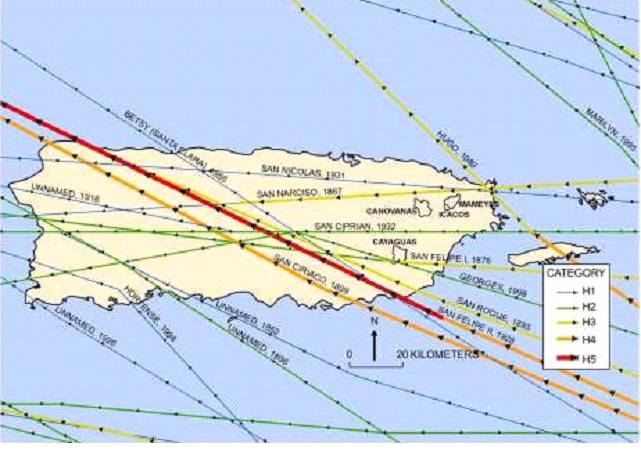
With the increasingly
rapid growth of independent former Spanish colonies in
the South and Central American states in the first part
of the 19th century, the Spanish Crown considered Puerto
Rico and Cuba of strategic importance. (…) Hundreds of
families, mainly from
Corsica,
France,
Germany,
Ireland,
Italy and Scotland, immigrated to the island.[38]
Free land was offered as an incentive to those who
wanted to populate the two islands on the condition that
they swear their loyalty to the Spanish Crown and
allegiance to the Roman Catholic Church.[38]
(…) In 1897,
Luis Muñoz Rivera
and others persuaded the liberal Spanish government to
agree to Charters of Autonomy for Cuba and Puerto Rico.
(…) On July 25, 1898, during the
Spanish–American War,
the U.S. invaded Puerto Rico with a landing at
Guánica.
As an outcome of the war, Spain ceded Puerto Rico, along
with the
Philippines
and
Guam,
then under Spanish sovereignty, to the U.S. under the
Treaty of Paris.
Spain relinquished sovereignty over Cuba, but did not
cede it to the U.S.[47]
(…) In 1917, the U.S.
Congress passed the
Jones-Shafroth Act,
popularly called the Jones Act, which granted Puerto
Ricans U.S. citizenship.[53]
Railroads in Puerto Rico
(end of 19th and 1st half of the
20th century)
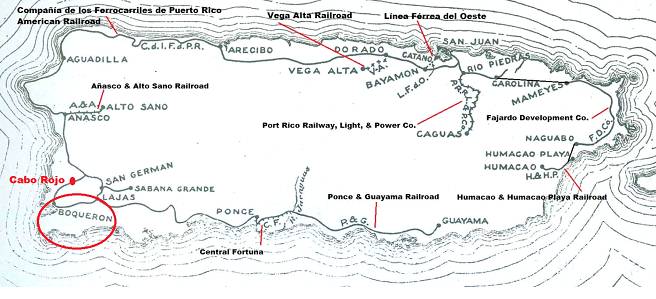
Detailed maps of the Cabo Rojo region
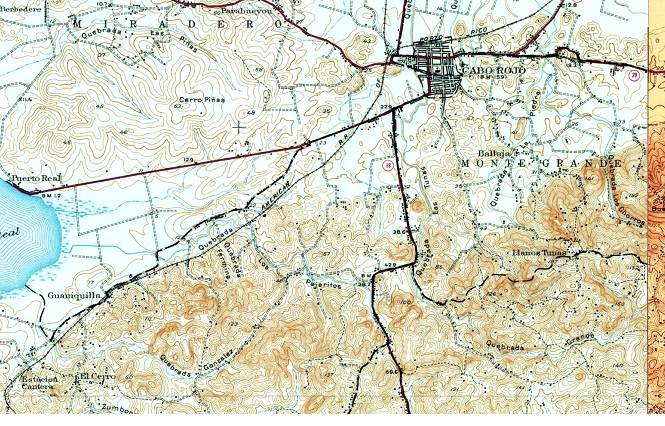
Cabo Rojo and Boqueron
Cabo Rojo
(Spanish
pronunciation: [ˈkaβo
ˈroxo])
is a
municipality
situated on the southwest coast of
Puerto Rico
and forms part of the
San Germán–Cabo Rojo metropolitan area.
(…) Despite the threat of pirates and Indians, the
Spanish settled the area of Los Morrillos around 1511.
By 1525,
salt mining
was an important industry in the area. (…) Cabo Rojo was
founded on December 17, 1771 by
Nicolás Ramírez de Arellano,
a descendant of Spanish nobility. (…) Boquerón is
a beach village located in the town of
Cabo Rojo, Puerto Rico.[1]
The village is one of the main tourist attractions in
the southwestern part of the island.[2]
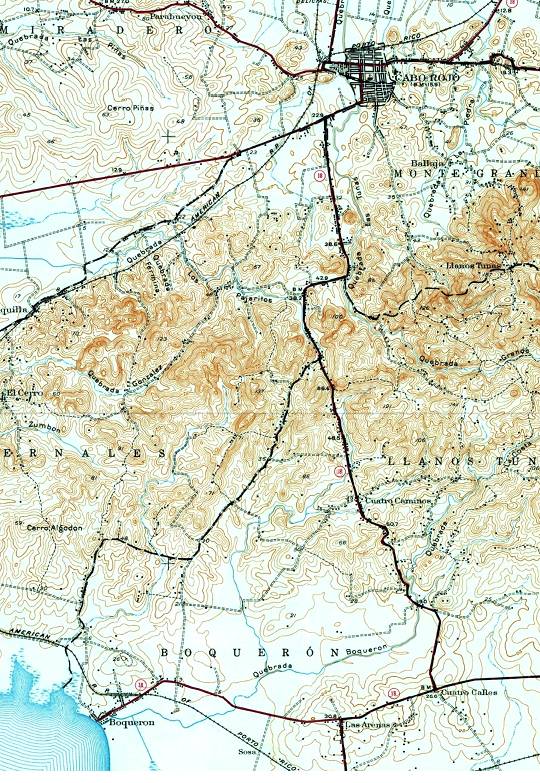
Summary
1) Name Cáceres
in old Spain
Ancestors
(?) of
Diego de Cáceres y Ovando and of the
Conquistador
Nicolás de Ovando y Cáceres:
Juan
Blázquez de Cáceres,
http://en.wikipedia.org/wiki/Juan_Bl%C3%A1zquez_de_C%C3%A1ceres
the
Conqueror of Cáceres,
who was a
Spanish
soldier and nobleman. Juan Blázquez de Cáceres was born
in
Ávila
and was at the Conquest of
Cáceres
(from the Arabs), on April 23, 1229, from which
he took his surname. He was married to Teresa Alfón and
had at
least one son –
Blazco Múñoz de Cáceres,
who died at 90 years and lived in
Cáceres
in 1270,
married to
Pascuala Pérez, daughter of Pascual Pérez and wife Menga
Marín, parents of -
Blazco Múñoz de Cáceres,
Founder
and 1st Lord of the Majorat of the same name, and
García Blázquez de Cáceres,
who by one Marina Pérez had -
Fernán Blázquez de Cáceres,
2nd
Lord
of the
Majorat
de Blazco Múñoz. They
were the ancestors
of the Marqueses de
Alcántara
(de Villavicencio del
Cuervo, May 13,
1667).[1]
---- ??? ---
Immediate Family of the Conquistador
of Hispaniola - Nicolás de Ovando y Cáceres
Diego Fernández de Cáceres y Ovando,
1st Lord of the
Manor House
del Alcázar Viejo, and his first wife Isabel Flores de
las Varillas – sons:
Diego de Cáceres y Ovando,
first-born son of Diego and his first wife Isabel
Flores de las
Varillas,
a distant relative of
Hernán Cortés.
Fray
Nicolás de Ovando y Cáceres,
The Conquistador
(born -
Brozas,
Extremadura,
1460 –
Died in
Madrid,
May 29, 1511), second son of
Diego Fernández de Cáceres y Ovando
and his
first wife Isabel Flores de las Varillas.
--- ??? ---
2)
Cáceres
names in Hispaniola/Santo Domingo
José Núñez
de Cáceres Albor
–
(born in [the city of] Santo Domingo in 1772,
died in 1846 in Mexico.
President of Spanish Haiti,
December 31, 1821 –
February 9, 1821
Manuel
Altagracia Cáceres
y Fernandez
– (born
Azua Province,
1838
- died 1878)
President
of the Dominican Republic,
3 January 1868
-
13 February 1868
General-in-Chief,
22 January 1874
-
6 April 1874.
Ramón
Arturo Cáceres Vasquez
-
(born 15 December 1866,
Moca,
Dominican Republic
– assassinated 19 November, 1911, [city
of]
Santo Domingo)
–
President of the Dominican Republic
-
(1906–1911)
3)
Cáceres
names and Family in Puerto Rico (Cabo Rojo)
Alonso de
Cáceres
– 1521, a “mayordomo” of the San Juan Cathedral
(the year of its construction)
--- ? ---
Felipe Cáceres-? /Inocencia Vasquez-? (? - ?) - from
Cabo Rojo, P.R.
 Juan de Dios Cáceres-Vasquez/Carmela Martinez-Colberg
(? - ?) (Barrio de Pedernales)
Juan de Dios Cáceres-Vasquez/Carmela Martinez-Colberg
(? - ?) (Barrio de Pedernales)
 Juan Silvestre Cáceres-Martinez (1897-1972)/Carlina
Ortiz-Ramirez-(Mercado) (1904-1968)
Juan Silvestre Cáceres-Martinez (1897-1972)/Carlina
Ortiz-Ramirez-(Mercado) (1904-1968)
Conclusions
Name Cáceres
in the “New World”
1)
It can be assumed that the paternal last name Cáceres
originates from the Province of Extremadura in
Spain, but it cannot be now determined, whether
people arriving here and bearing this last name were
born in the region (province) of Cáceres
or in the town itself. The name Cáceres
dates back in Spain to the 13th century.
2)
The ancestor of Nicolás Ovando y Cáceres, who
came to this continent and became the first Spanish
governor of the (West) Indies in 1502,
was born in Brosaz, (Extremadura?) in
1460. His ancestor Juan Blázquez de Cáceres
was born in
Ávila.
He was a
Spanish
soldier and nobleman and was at
the Conquest
of Cáceres,
(province and/or town? - from the Arabs), on
April 23, 1229, from which he took his surname
and title “de Caceres” (and passed it on to
his successors).
3)
It can be assumed that all persons “of importance” –
conquistadors/conquerors and administrators
(Governors, Viceroys) belonged to the nobility. They
were:
Nicolás Ovando y
Cáceres
(see above – came to the West Indies);
Alonso de Cáceres y
Retes,
(born in
Alcántara,
Cáceres
in late fifteenth century) was since around 1530,
a
conquistador of Central and South America;
Francisco Antonio
de
Cáceres Molinedo
–
born (?), was a Spanish
Governor of Nicaragua
– 1745;
Luís de
Albuquerque de Melo Pereira e Cáceres,
(and his brother João, both were - )
Governador de Mato Grosso,
Brasil from 1772 to 1789 - they were
born in contemporary Portugal
(across from Extremadura).
4)
Ancestry of others, (who were found in the
Internet), and who were born later, already outside
of Spain (“criollos”), could not be established.
They could have been of a noble descent or
professionals, tradesman or “commoners”, who
accompanied the Conquistadors during settling and
administration of the conquered lands. They could
have been using the same last name to signify that
they also came (from) “de Caceres”. We would need an
expert opinion in this matter. To this group belong:
María Luisa Cáceres
Díaz de Arismendi
– born in Venezuela in 1799, (of
Canarian descent)
José Bernardo
Cáceres
–
born in Chile (?), junior
commander in the battle of Maipu, Chile in
1818
Andrés Avelino Cáceres
Dorregaray
– born in Peru in
1836,
President of Chile x3,
1883-1895
Luis Caceres
-
Privisional
Governor
of the
Argentine
province
of
Córdoba
–
1866
Caceres in
Hispaniola/Santo Domingo (SD)/Dominican Republic(DR)
José Núñez de
Cáceres Albor
–
(born SD in 1772, died in 1846
– Mexico). President - 1821
Manuel
Altagracia Cáceres
y Fernandez
– (born
SD in 1838, died in 1878).
President - 1868
Ramón Arturo
Cáceres Vasquez
- (born DR in 1866, assasinated in
1911). President -
1906-1911
Caceres in Puerto Rico
So far, we have found
only one early entry of this name during our search
in Puerto Rico. This was:
Alonso de
Cáceres
– in 1521, a “mayordomo” of the San Juan
Cathedral (the year of its construction).
We have no information
about his descendants.
Puerto Rico was claimed by
Christopher
Columbus
for Spain during his second voyage to the Americas
on November 19, 1493, (the Spanish settled
the area of Los Morrillos [Cabo Rojo] around
1511). No other details are available to us.
Verbal Information
obtained from the family describes three earlier
generations of this family (exact birthdates are not
known), which gets us back to around the middle of
the 19th century, when they already lived
in Cabo Rojo. There are no other known
records about any other family branches. Perhaps,
the ancestors of this family arrived from Santo
Domingo at the beginning of the 19th
century – escaping the political instability,
oppression, danger to their lives, land
expropriations, and collapse of the economy.
We were unable to make
any direct connections with the Caceres families
discovered in the Dominican Republic – but, also
based on the initial location of the family in Cabo
Rojo (a short distance from the shores of Santo
Domingo), it should be considered that they may have
come from there.
Destruction and loss of
property and income resulting from several
hurricanes and an earthquake, which devastated this
part of the island during the early part of the 20th
century, may have caused subsequent migration to the
North Coast, to the San Juan area.
Or, are they
descendants of earlier Spanish settlers, who arrived
here in 1511?)
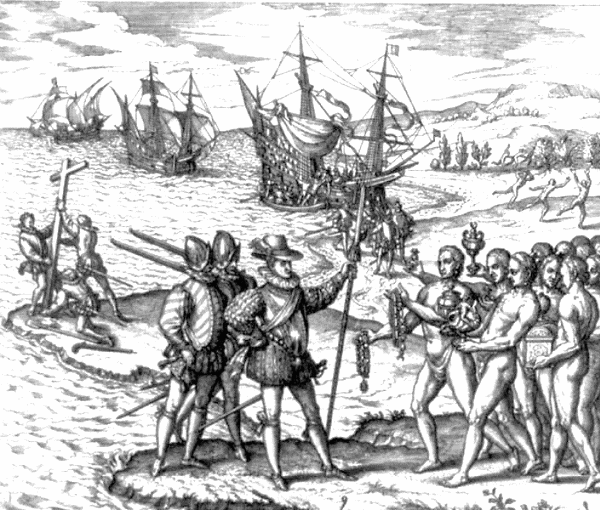
Christopher Columbus landing on the
island of Hispaniola in 1492.
1)
Gen. W³adys³aw Franciszek
Jab³onowski;
2)
Although he unofficially led the nation politically
during the revolution, Toussaint L'Ouverture is
considered the father of Haiti.
3) Jean Jacques
Dessalines
became Haiti's first emperor in 1804
|